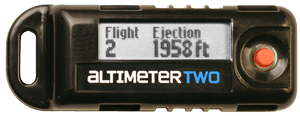Jolly Logic AltimeterTwo
JL-A2
Regular price $79.95AltimeterTwo is an instant flight analysis tool for model rocketry, no computer required. It is small enough to fit in most rockets, and it provides 10 key flight performance measures on its sunlight-readable screen for each flight, including max altitude, top speed, engine thrust duration, peak acceleration, ejection timing, and total flight time.
No batteries required. AltimeterTwo is rechargeable and includes a recharging cable that works in common USB ports.
Approved for National Association of Rocketry contests.
Will only work for model rockets.
Size: |
49mm x 18mm x 14.5mm (1.9″ x 0.7″ x 0.57″) |
Weight: |
9.9 g (0.35 oz) |
DESCRIPTION
A rechargeable digital altimeter (for model rockets only) that analyzes flight altitude, acceleration, top speed, flight duration and 6 other important flight statistics.
The AltimeterTwo retains the rugged design, easily-readable LCD, small size, and rechargeability of the AltimeterOne. With the addition of a 3-axis accelerometer and a 4X speed increase in processing speed, it can provide a full suite of important flight statistics that can help you analyze and improve your rocket’s performance.
AltimeterTwo has been approved by the National Association of Rocketry for use in rocketry competitions.

Features
- 3-axis, 24g accelerometer can detect launch, acceleration, speed, ejection, and landing
- Accurate 19-bit barometric pressure sensor sensitive to altitude changes of less than one foot
- Daylight-readable LCD display clearly displays all flight statistics−no computer needed
- History feature stores last 100 flights
- Rechargeable Lithium Polymer battery lasts for hundreds of launches, no batteries to buy
- Recharges in less than 2 hours from any standard USB port (cable included)
- Samples pressure 25 times/second, and acceleration over 250 times/second
- The power button turns device ON/OFF and RESETs the display between flights
- Automatically powers down after 2 hours to conserve power
- Handy tether point allows secure attachment
- Rugged ABS construction to survive crashes
- Approved for use in official contests
- Displays results in either English or metric units
(If you think of any improvements, email them to us at support@jollylogic.com.)
Size and Weight
|
English
|
Metric
|
|
|---|---|---|
| Size | 0.57″ x 0.71″ x 1.93″ | 14.5mm x 18mm x 49mm |
| Weight | 0.36 ounces | 9.9 grams |
Range and Precision
|
English
|
Metric
|
|
|---|---|---|
| Max Altitude (above sea level) | 29,500 feet | 9000 meters |
| Max Acceleration | Minimum of 23 gees Maximum of 40 gees (careful mounting) |
Minimum of 23 gees Maximum of 40 gees (careful mounting) |
| Altitude Precision | Nearest foot | Nearest meter |
| Acceleration Precision | Measured to nearest 0.0007 gee Displayed to nearest 0.1 gee |
Measured to nearest 0.0007 gee Displayed to nearest 0.1 gee |
| Speed Precision | Nearest MPH | Nearest meter/sec |
| Timing Precision | Shown to nearest 0.1 second | Shown to nearest 0.1 second |
Simple Instructions
Just want the basics? Here’s how to use the AltimeterTwo, in as brief a form as possible:1. Press and release the button quickly to turn the AltimeterTwo on or off.
2. Clear and reset for the next flight by holding the button down and releasing it when “Launch” appears.
3. Recharge by plugging it into a USB port on a computer. Make sure a red light appears when you plug it in; take it out after the green light appears.
AltimeterTwo User Guide
Step-by-Step Tour
Here’s a detailed walk-through of how to operate the AltimeterTwo.
Turning It On and Off
Press the button and release it quickly to turn the AltimeterTwo on and off.
Accessing the Menu
If you press the button and continue to hold it down, you will see Menu and then be presented with a series of scrolling choices on the screen, one after another, which you can select by letting go of the button.
Resetting for the Next Flight
If you hold down the button and let go when you see “Launch”, AltimeterTwo will create a new flight record and be ready for the next flight. On the screen, you will now see “Ready”.
After the Flight
The AltimeterTwo will automatically display each of the flight analysis items for each flight.
Flight History
To see the last 100 flights, hold down the button until you see “History,” then release. The last 100 flights will be shown, most recent first. To exit the list, press the button quickly.Here are the flight aspects analyzed by AltimeterTwo:
|
Statistic
|
Screen
|
What It Means
|
|
|---|---|---|---|
|
1
|
Maximum Altitude
|
 |
The highest altitude achieved in flight
|
|
2
|
Top Speed
|
 |
The top speed of the rocket, measured at the end of the engine thrust phase (in MPH or m/s)
|
|
3
|
Thrust Time
|
 |
The length of time (in hundredths of seconds) that the engine produces thrust
|
|
4
|
Peak Acceleration
|
 |
The maximum rocket acceleration sustained for at least 1/60th of a second during engine burn (in Gs)
|
|
5
|
Average Acceleration
|
 |
The average acceleration from ignition until motor burnout (in Gs)
|
|
6
|
Coast to Apogee Time
|
 |
The delay between motor burnout and the moment of highest flight (in seconds)
|
|
7
|
Apogee to Ejection Time
|
 |
The time between the peak of flight and parachute ejection; can be negative if ejection is on the way up (in seconds)
|
|
8
|
Ejection Altitude
|
 |
The altititude at which the parachute is ejected (in feet or meters)
|
|
9
|
Descent Rate
|
 |
The average vertical speed from ejection to landing (in MPH or m/s)
|
|
10
|
Duration
|
 |
Time of flight from ignition to landing (in seconds)
|












